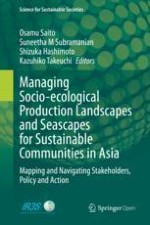2.1 Introduction
2.1.1 Ocean Policy in Japan
2.1.2 Objective of This Chapter
2.2 Method
2.2.1 The Social-Ecological Systems (SES) Schematic
2.2.2 Review of the Policy Interventions
2.3 Results


Open Access 2020 | OriginalPaper | Buchkapitel
verfasst von : Mitsutaku Makino, Masakazu Hori, Atsushi Nanami, Juri Hori, Hidetomo Tajima
Erschienen in: Managing Socio-ecological Production Landscapes and Seascapes for Sustainable Communities in Asia
Verlag: Springer Singapore
Aktivieren Sie unsere intelligente Suche, um passende Fachinhalte oder Patente zu finden.
Wählen Sie Textabschnitte aus um mit Künstlicher Intelligenz passenden Patente zu finden. powered by
Markieren Sie Textabschnitte, um KI-gestützt weitere passende Inhalte zu finden. powered by
